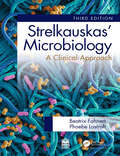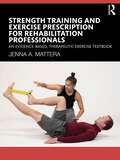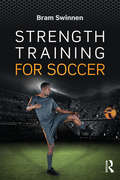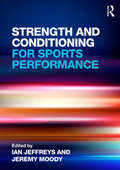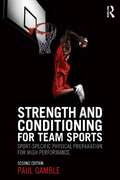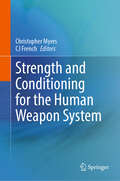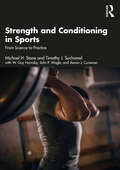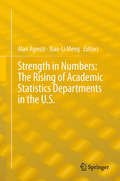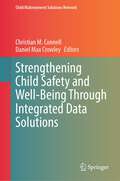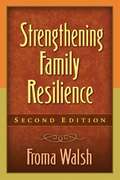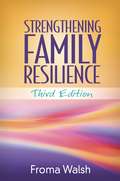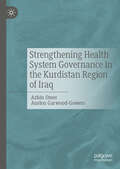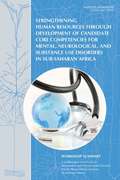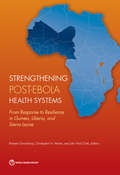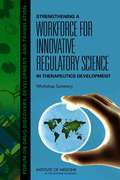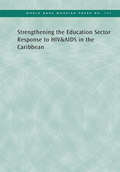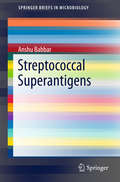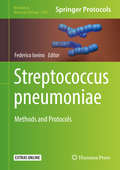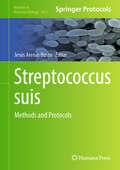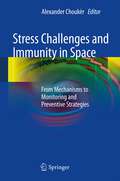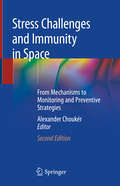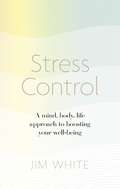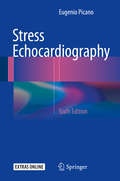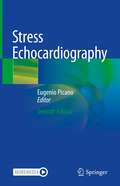- Table View
- List View
Strelkauskas' Microbiology: A Clinical Approach
by Phoebe Lostroh Beatrix FahnertAs with the much-praised prior editions, the third edition of Strelkauskas' Microbiology: A Clinical Approach remains a comprehensive introductory textbook written specifically for pre-nursing, nursing and allied health students. Clinically relevant throughout, it uses the theme of infection as its foundation, fitting closely with the 'One Health' approach that is considered increasingly central to the effective control of zoonoses and to combatting antimicrobial resistance. The third edition has been thoroughly revised and updated to reflect the latest developments, including the emergence of the SARS-CoV-2 virus and associated COVID-19 pandemic. The book is accompanied by a robust instructor ancillary package that allows educators to incorporate readily the book’s unique approach into their lectures and includes additional materials for students to supplement classroom learning and encourage and support study and self-reflection. Key Features: Student-focused, with all elements carefully designed to help students engage with and understand difficult concepts and to spark and hold interest Dedicated learning skill section introduces practical strategies for improving comprehension and retention Numerous text features further support learning and teaching, including chapter overviews, fast facts, case studies and human stories, and ‘why is this important?’ highlights A variety of question-and-answer types for self-testing and reflection to support and assess basic learning, to challenge students to integrate important concepts and ask students to apply what they have just learned to a specific clinical setting or problem All supported by a comprehensive suite of online resources including lecturer support material and, for students, interactive questions, lecture notes, MicroMovies and the BugParade The book is an excellent resource to guide and support inter-professional education in the health sciences and an ideal entry-point to the subject for anyone coming from another discipline and invaluable supplementary reading for medical, microbiology and biomedical science students.
Strength Training and Exercise Prescription for Rehabilitation Professionals: An Evidence-based, Therapeutic Exercise Textbook
by Jenna A. MatteraStrength Training and Exercise Prescription for Rehabilitation Professionals is a modern, evidence-based, therapeutic exercise textbook written for clinicians, by a clinician. The content aims to fill any gaps in exercise knowledge and truly highlights the application and integration of progressive resistance training into the rehabilitation setting. This book delivers a vast, well-researched exercise library and provides sound guidance on developing a comprehensive exercise program, including exercise selection, prescription, and dosing for any individual.Strength Training and Exercise Prescription for Rehabilitation Professionals details a variety of progressions and regressions that allow a primary movement pattern – the squat, deadlift, bridge, push, pull, and carry – to be performed by individuals of all ages, body types, and experience levels. It considers specific factors that apply to injured populations, like pain, phase of healing, pre-requisite range of motion, and strength requirements. The exercise chapters feature many pieces of resistance training equipment, but also explain how to perform and modify bodyweight exercises to achieve the desired training effect, as access to equipment often varies. High-quality images are paired with step-by-step, written explanations, and valuable coaching cues aim to aid instruction and execution. In addition, it also highlights current evidence for rehabilitation of specific diagnoses, including Anterior Cruciate Ligament (ACL) reconstruction, lower back pain, patella, and Achilles tendinopathy.This textbook is an excellent resource for new clinicians and seasoned professionals who desire concise, factual guidance and reference to support the development of their rehabilitative exercise programs. It would be a worthwhile addition to the curriculum of any physical therapy, chiropractic, or athletic training program, but is also appropriate for anyone that may interact closely with rehabilitation clinicians, like strength and conditioning coaches, personal trainers, exercise physiologists, and other fitness professionals with one common goal: improve quality of care and maximize patient outcomes through exercise.
Strength Training for Soccer
by Bram SwinnenStrength and power are key elements of soccer performance. A stronger player can sprint faster, jump higher, change direction more quickly and kick the ball harder. Strength Training for Soccer introduces the science of strength training for soccer. Working from a sound evidence-base, it explains how to develop a training routine that integrates the different components of soccer performance, including strength, speed, coordination and flexibility, and outlines modern periodization strategies that keep players closer to their peak over an extended period. Dealing with themes of injury prevention, rehabilitation and interventions, as well as performance, the book offers a uniquely focused guide to the principles of strength and conditioning in a footballing context. Fully referenced, and full of practical drills, detailed exercise descriptions, training schedules and year plans, Strength Training for Soccer is essential reading for all strength and conditioning students and any coach or trainer working in football.
Strength and Conditioning for Sports Performance
by Ian Jeffreys Jeremy MoodyAn effective strength and conditioning program is an essential component of the preparation of any athlete or sportsperson. Strength and Conditioning for Sports Performance is a comprehensive and authoritative introduction to the theory and practice of strength and conditioning, providing students, coaches and athletes with everything they need to design and implement effective training programs. The book includes a clear and rigorous explanation of the core science underpinning strength and conditioning techniques and gives a detailed, step-by-step guide to all of the key training methodologies, including training for strength, speed, endurance, agility, flexibility as well as plyometrics. Throughout the book the focus is on the coaching process, with every chapter highlighting the application of strength and conditioning techniques in everyday coaching situations. The book also includes a unique and extensive section of sport-specific chapters, each of which examines in detail the application of strength and conditioning to a particular sport, from soccer and basketball to golf and track and field athletics. The book includes contributions from world-leading strength and conditioning specialists in every chapter, including coaches who have worked with Olympic gold medallists and international sports teams at the very highest level. Strength and Conditioning for Sports Performance is an essential course text for any degree level student with an interest in strength and conditioning, for all students looking to achieve professional accreditation, and an invaluable reference for all practising strength and conditioning coaches.
Strength and Conditioning for Team Sports: Sport-Specific Physical Preparation for High Performance, second edition
by Paul GambleStrength and Conditioning for Team Sports is designed to help trainers and coaches to devise more effective high-performance training programs for team sports. This remains the only evidence-based study of sport-specific practice to focus on team sports and features all-new chapters covering neuromuscular training, injury prevention and specific injury risks for different team sports. Fully revised and updated throughout, the new edition also includes over two hundred new references from the current research literature. The book introduces the core science underpinning different facets of physical preparation, covering all aspects of training prescription and the key components of any degree-level strength and conditioning course, including: physiological and performance testing strength training metabolic conditioning power training agility and speed development training for core stability training periodisation training for injury prevention Bridging the traditional gap between sports science research and practice, each chapter features guidelines for evidence-based best practice as well as recommendations for approaches to physical preparation to meet the specific needs of team sports players. This new edition also includes an appendix that provides detailed examples of training programmes for a range of team sports. Fully illustrated throughout, it is essential reading for all serious students of strength and conditioning, and for any practitioner seeking to extend their professional practice.
Strength and Conditioning for the Human Weapon System
by Christopher Myers Cj FrenchA central focus of the US Military is the Human Weapon System (HWS) and the optimization of this weapon system. Over the past decade, the Department of Defence has invested in programs termed Human Performance Optimization (HPO) programs. Human performance for the human weapon system is much different than the civilian athlete. Therefore, the human weapon system's rehabilitation and performance training requirements are different and must be considered. This book demonstrates the following to strength coaches and practitioners: Why to view the HWS as a multi-faceted system that requires a more inclusive program than needed by athletes. Provide updated methodology to create a strength and conditioning program specifically for the HWS populations. Introduce and define advanced strength and conditioning methodologies SC professionals use within the US Military and law enforcement performance programs.
Strength and Conditioning in Sports: From Science to Practice
by Michael H. Stone Timothy J. Suchomel W. Guy Hornsby John P Wagle Aaron J. CunananA good sport scientist and coach must understand both the underlying mechanisms and the practical application of training principles. Strength and Conditioning in Sports: From Science to Practice is unique in that it covers both of these areas in a comprehensive manner. This textbook "connects" the mechanism with practical application. Selecting the appropriate training process is paramount to success in competitive sport. A major component of this textbook is the detailed explanations of developing that process from creating an annual plan, selection of the appropriate periodization model and how to program that model. In application, connecting physiology to performance can be enhanced by using appropriate athlete monitoring techniques. Although there can be overlap, monitoring can be divided into two components: fatigue management and program efficacy. One of the features of this text is the in-depth description of how the monitoring process should take place and how monitoring data can be used in program application. This exciting new text provides a comprehensive overview of the application of science to sport and will be key reading for undergraduate and postgraduate students of strength and conditioning, athletic training, exercise physiology, human performance, personal training, and other related disciplines of sport science and kinesiology.
Strength in Numbers: The Rising of Academic Statistics Departments in the U. S.
by Alan Agresti Xiao-Li MengStatistical science as organized in formal academic departments is relatively new. With a few exceptions, most Statistics and Biostatistics departments have been created within the past 60 years. This book consists of a set of memoirs, one for each department in the U.S. created by the mid-1960s. The memoirs describe key aspects of the department's history -- its founding, its growth, key people in its development, success stories (such as major research accomplishments) and the occasional failure story, PhD graduates who have had a significant impact, its impact on statistical education, and a summary of where the department stands today and its vision for the future. Read here all about how departments such as at Berkeley, Chicago, Harvard, and Stanford started and how they got to where they are today. The book should also be of interests to scholars in the field of disciplinary history.
Strengthening Child Safety and Well-Being Through Integrated Data Solutions (Child Maltreatment Solutions Network)
by Christian M. Connell Daniel Max CrowleyThis book explores the use of integrated administrative data to understand and address the significant public health problem of child maltreatment. It examines the use of linked, or integrated, administrative data to increase understanding of population-level needs – and to inform decision-making efforts – within the child welfare system and across other public systems. The book details the technological innovations that have allowed for the accumulation and centralization of large datasets critical to identifying risks of child maltreatment and its negative consequences and to target community and system responses more accurately to address these challenges. Leading experts from the fields of child maltreatment, child welfare, and human services research share their insights and experiences at the forefront of this critical research area and how it is shaping understanding of identification, intervention, and policy affecting children and families. Key areas of coverage include:Ways in which these data can be leveraged to promote more effective efforts to detect, prevent, and respond to child maltreatment.Emerging and innovative approaches in the acquisition and use of administrative data to inform the societal and governmental response to child maltreatment.The use of multisystem data and integrated data systems to conduct predictive analytics, risk monitoring, or policy- and program-focused research and evaluation to inform child welfare system solutions. Strengthening Child Safety and Well-Being Through Integrated Data Solutions is a must-have volume for researchers, professors, and graduate students as well as clinicians, practitioners, policy makers, and related professionals across such disciplines as child and school psychology, social psychology, developmental psychology, public health, clinical social work, educational and public policy, and all related disciplines.
Strengthening Family Resilience, Second Edition
by Froma Walsh Susan McdanielThis informative clinical resource and text presents Froma Walsh's family resilience framework for intervention and prevention with clients dealing with adversity. Drawing on extensive research and clinical experience, the author describes key processes in resilience for practitioners to target and facilitate. Useful guidelines and case illustrations address a wide range of challenges sudden crisis, trauma, and loss; disruptive transitions, such as job loss, divorce, and migration; persistent multistress conditions of serious illness or poverty; and barriers to success for at-risk youth. New to This Edition Reflects the latest research and practice advances. Chapter on resilience-oriented approaches to recovery from major disasters. Chapter on applications in community-based programs and international contexts.
Strengthening Family Resilience, Third Edition
by Froma WalshIn this widely used course text and practitioner resource, Froma Walsh provides a state-of-the-art framework for understanding resilience in families and how to foster it. Illuminating the complex interplay of biopsychosocial influences in risk and resilience, she identifies key transactional processes that enable struggling families to grow stronger and more resourceful. Case illustrations demonstrate Walsh's collaborative approach with diverse families facing a wide range of crisis situations and chronic multistress challenges. The book features practice principles, tools, and guidelines, as well as programmatic applications. New to This Edition *Incorporates the latest practice advances and resilience research. *Chapter on assessment tools and strategies. *Chapter on disruptive transitions across the family life cycle. *Expanded coverage of war-related and collective trauma.
Strengthening Health System Governance in the Kurdistan Region of Iraq
by Austen Garwood-Gowers Azhin OmerThis book is a nuanced study of healthcare provision and health systems governance in the Kurdistan Region in Iraq (KRI). The authors address an important knowledge gap, offering compelling insights into health systems and governance in Kurdistan before and after the start of the Covid-19 pandemic. The findings stem from a system of benchmarking derived from both a comparative analysis of international healthcare standards and original empirical research. In light of the benchmarks of best practices for health system governance and the findings from in-depth qualitative interviews, the authors critically discuss the strengths and weaknesses in KRI healthcare governance and put forward pathways for reform. This thought-provoking book contributes to an important area of research on contemporary health systems governance and healthcare provision in low-income countries and war-affected regions.
Strengthening Human Resources Through Development of Candidate Core Competencies for Mental, Neurological, and Substance Use Disorders in Sub-Saharan Africa
by Institute of Medicine Theresa M. Wizemann Bruce M. Altevogt Board on Health Sciences Policy Diana E. Pankevich Patricia A. Cuff A Collaboration of the Forum on Neuroscience and Nervous System Disorders and the African Science Academy Development InitiativeOne of the largest treatment gaps for mental, neurological, and substance use (MNS) disorders in the world can be seen in Sub-Saharan Africa (SSA). According to the World Health Organization (WHO), about 80% of people with serious MNS disorders living in low- and middle-income countries do not receive needed health services. A critical barrier to bridge this treatment gap is the ability to provide adequate human resources for the delivery of essential interventions for MNS disorders. An international workshop was convened in 2009, by the .S. Institute of Medicine (IOM) Forum on Neuroscience and Nervous Systems Disorders and the Uganda National Academy of Sciences (UNAS) Forum on Health and Nutrition, to bring together stakeholders from across SSA and to foster discussions about improving care for people suffering from MNS disorders and what steps, with potential for the greatest impact, might be considered to bridge the treatment gap. Due to the broad interest to further examine the treatment gap, the IOM forum organized a second workshop in Kampala, Uganda on September 4 and 5, 2012. The workshop\'s purpose was to discuss candidate core competencies that providers might need to help ensure the effective delivery of services for MNS disorders. The workshop focused specifically on depression, psychosis, epilepsy, and alcohol use disorders. Strengthening Human Resources Through Development of Candidate Core Competencies for Mental, Neurological, and Substance Use Disorders in Sub-Saharan Africa: Workshop Summary outlines the presentations and discussions by expert panelists and participants of the plenary sessions of the workshop. This summary includes an overview of challenges faced by MNS providers in the SSA, perspectives on the next steps, the 2009 workshop, and more.
Strengthening Post-Ebola Health Systems: From Response to Resilience in Guinea, Liberia, and Sierra Leone
by Christopher H. Herbst Ramesh GovindarajThe Ebola virus outbreak ravaged parts of West Africa during 2013†“16, particularly in Guinea, Liberia, and Sierra Leone. The epidemic had very high human, social, and economic costs; food became scarce, schools were shut down, and ongoing development programs shifted to support the immediate response efforts. The rapid spread of the disease demonstrated the urgent need to invest in health systems and to establish surveillance and preparedness programs for long-term resilience. Strengthening Post-Ebola Health Systems was initiated when Ebola was still raging, in 2015. The book focuses on some of the most critical needs for public health resilience and emergency preparedness: adequate fiscal space, an effective health workforce, and ongoing disease surveillance. Drawing on the Post-Ebola Planning Strategies of Guinea, Sierra Leone, and Liberia, the book highlights key strategies and investment opportunities that governments and partners might leverage to make health systems more efficient, resilient, and sustainable. The lessons from this book are expected to help guide efforts to rebuild the health systems of Guinea, Liberia, and Sierra Leone, but they can also be applied to other low-income countries in Sub-Saharan Africa. This book will be of interest to policy makers, health practitioners, and development partners who support pandemic preparedness and health-system-strengthening efforts around the world.
Strengthening a Workforce for Innovative Regulatory Science in Therapeutics Development
by Institute of Medicine Steve Olson Forum on Drug Discovery, Development, and Translation Anne B. Claiborne Board on Health Sciences PolicyThe development and application of regulatory science - which FDA has defined as the science of developing new tools, standards, and approaches to assess the safety, efficacy, quality, and performance of FDA-regulated products - calls for a well-trained, scientifically engaged, and motivated workforce. FDA faces challenges in retaining regulatory scientists and providing them with opportunities for professional development. In the private sector, advancement of innovative regulatory science in drug development has not always been clearly defined, well coordinated, or connected to the needs of the agency. As a follow-up to a 2010 workshop, the IOM held a workshop on September 20-21, 2011, to provide a format for establishing a specific agenda to implement the vision and principles relating to a regulatory science workforce and disciplinary infrastructure as discussed in the 2010 workshop.
Strengthening the Education Sector Response to HIV and AIDS in the Caribbean
by World BankThe Caribbean Region is second only to Africa in the impact of HIV and AIDS. The Caribbean Community (CARICOM) has responded to this challenge by promoting a multisectoral response to the epidemic. UNESCO has provided regional leadership in strengthening the education sector component of this response. In 2005, UNESCO launched, with CARICOM and the World Bank, a regioinal dialogue involving representatives of Ministries of Education, national HIV and AIDS coordinating councils, development partners, and regional institutions providing leadership in the HIV response, which led to the development and endorsement of a regional Proposal for Action: Accelerating the Education Sector Response to HIV and AIDS in the Caribbean Region. In June 2006, Ministers of Education and representatives of National AIDS AUthorities met in Port-of-Spain, Trinidad and Tobago, under the auspices of the CARICOM Council on Human and Social Development, and agreed to promote education sector leadership in addressing HIV and AIDS and to create a supportive policy and financial environment at national and regional levels. This report describes the development of these regional processes and how they have led to a stronger education sector response at the regional level. It also focuses on developments in three countries (Guyana, Jamaica, and St. Lucia) as examples of how this regional effort translates into action at the national level.
Streptococcal Superantigens
by Anshu BabbarThis book provides ample knowledge and better understanding of Streptococcus pyogenes and their superantigens. Many illustrations make this a highly informative book. This book elucidates briefly Streptococcus pyogenes as a strict human pathogen possessing an array of virulence factors. These help in evading host immune responses such as by the activation of non-specific T-cell subpopulations by producing superantigens. This book mainly focuses on streptococcal superantigens and explains how they are different from conventional antigens. Moreover, it elaborates those diseases in which superantigens are actively involved. Useful aspects of superantigens and different therapeutic interventions to eradicate superantigens induced diseased are also discussed.
Streptococcus pneumoniae: Methods and Protocols (Methods In Molecular Biology #1968)
by Federico IovinoThis volume looks at the newest methods, materials, equipment, and technologies developed to study the cell biology of the pneumococcus. The chapters, which cover a wide range of topics, are organized into six parts: Part one discusses the cultivation of Streptococcus pneumoniae in vitro; Part Two talks about the microscopy techniques used to study the biology of Streptococcus pneumoniae and pneumococcal interactions with the host; Parts Three and Four describe the genetics, proteome, and proteomics of Streptococcus pneumoniae; Part Five explains in vitro and in vivo models of Streptococcus pneumoniae-host interactions; and Part Six looks at the factors of public health, epidemiology, and biostatistics. Written in the highly successful Methods in Molecular Biology series format, chapters include introductions to their respective topics, lists of the necessary materials and reagents, step-by-step, readily reproducible laboratory protocols, and tips on troubleshooting and avoiding known pitfalls.Cutting-edge and authoritative, Streptococcus pneumoniae: Methods and Protocols is a valuable resource for both novice and expert researchers who want to expand their studies into new areas and new systems in this continuously evolving field.
Streptococcus suis: Methods and Protocols (Methods in Molecular Biology #2815)
by Jesús Arenas BustoThis volume covers the classic and new techniques used to study the zoonotic pathogen Streptococcus suis. The chapters in this book cover are organized in four sections and cover topics such as techniques for cultivation, isolation, typing of S. suis biofilm formation and genetic manipulation; analysis of antibiotic resistance and transference; detection in pigs and infection models; and evaluation of economic impact and prevention. Written in the highly successful Methods in Molecular Biology series format, chapters include introductions to their respective topics, lists of the necessary materials and reagents, step-by-step, readily reproducible laboratory protocols, and tips on troubleshooting and avoiding known pitfalls. Comprehensive and thorough, Streptococcus suis: Methods and Protocols is a valuable resource for both novel and expert researchers who want to expand their knowledge of this important field.
Stress Challenges and Immunity in Space
by Alexander ChoukerStress of either psychological or physical nature can activate and/or paralyse humans' innate and adaptive immunity. However, adequate immunity is crucial to the maintenance of health on earth and in space. During space flight, human physiology and health are challenged by complex environmental stressors which might be at their most pronounced during lunar or interplanetary missions. While previous publications have addressed the physiological changes that occur during space flight, this book goes further, by adopting an interdisciplinary approach to analyze the complex interaction of living conditions in space, the immune system, and astronauts' health. It is explained how such analysis of the consequences of stress for the immune system may help in preventing, diagnosing, and counteracting immune-related alterations in health on earth as well as in space
Stress Challenges and Immunity in Space: From Mechanisms to Monitoring and Preventive Strategies
by Alexander ChoukérThis book explains how stress – either psychological or physical – can activate and/or paralyse human innate or adaptive immunity. Adequate immunity is crucial for maintaining health, both on Earth and in space. During space flight, human physiology is specifically challenged by complex environmental stressors, which are most pronounced during lunar or interplanetary missions. Adopting an interdisciplinary approach, the book identifies the impact of these stressors – the space exposome – on immunity as a result of (dys-)functions of specific cells, organs and organ networks. These conditions (e.g. gravitation changes, radiation, isolation/confinement) affect immunity, but at the same time provide insights that may help to prevent, diagnose and address immune-related health alterations. Written by experts from academia, space agencies and industry, the book is a valuable resource for professionals, researchers and students in the field of medicine, biology and technology.The chapters “The Impact of Everyday Stressors on the Immune System and Health”, “Stress and Radiation Responsiveness” and “Assessment of Radiosensitivity and Biomonitoring of Exposure to Space adiation” are available open access under a Creative Commons Attribution 4.0 International License via link.springer.com.
Stress Control: A Mind, Body, Life Approach to Boosting Your Well-being
by Jim WhiteStress is part and parcel of life. We all get it. Think of blood pressure. If you are alive, you have blood pressure. If you are alive, you have stress. If your blood pressure gets too high, you should do something about it. The same is true with stress and this book will help you to control it.Stress can be a mixture of anxiety, depression, panic feelings, poor sleep, low self-confidence, low self-esteem and a poor sense of wellbeing. It is one of the most common problems in the world today. But controlling your stress doesn't have to mean expensive therapy or a long waiting list for a referral to a service. This book will teach you to become your own therapist:· Learn about stress and how it affects you· Follow straight-forward steps to get an instant sense of control· Develop a set of linked skills for long-term stress management· Boost your wellbeing· Feel in control of your futureThis accessible, jargon-free book combines clinically proven methods from cognitive behavioural therapy (CBT), positive psychology and mindfulness to give you the tools you need to improve your mind, your body and your life.
Stress Echocardiography
by Eugenio PicanoThis sixth edition is enriched by over 300 figures, 150 tables and a video-companion collecting more than 100 cases also presented in the format of short movies and teaching cartoons. This extensively revised and enlarged edition of this long-seller documents the very significant advances made since the fifth (2009) edition and is entirely written by Eugenio Picano, a pioneer in the field sharing his lifetime experience with the help of an international panel of 50 contributors from 22 countries representing some of the best available knowledge and expertise in their respective field. In a societal and economic climate of increasing pressure for appropriate, justified and optimized imaging, stress echocardiography offers the great advantages of being radiation-free, relatively low cost, and with a staggering versatility: we can get more (information) with less (cost and risk). For a long time, the scope and application of stress echo remained focused on coronary artery disease. In the last ten years, it has exploded in its breadth and variety of applications. From a black-and-white, one-fits-all approach (wall motion by 2D-echo in the patient with known or suspected coronary artery disease) now we have moved on to a omnivorous, next-generation laboratory employing a variety of technologies (from M-Mode to 2D and pulsed, continuous, color and tissue Doppler, to lung ultrasound and real time 3D echo, 2D speckle tracking and myocardial contrast echo) on patients covering the entire spectrum of severity (from elite athletes to patients with end-stage heart failure) and ages (from children with congenital heart disease to the elderly with low-flow, low-gradient aortic stenosis).
Stress Echocardiography
by Eugenio PicanoThis is the seventh edition of a long-selling book (first edition 1991) that was translated into Italian, French, Chinese, Portuguese, Spanish, English. In the last ten years, stress echocardiography has exploded in its breadth and variety of applications. From a one-fits-all approach (wall motion by 2D-echo in the patient with known or suspected coronary artery disease), the field has progressed to an omnivorous, next-generation laboratory employing a variety of technologies (from M-Mode to 2D, from pulsed, continuous, color and tissue Doppler to lung ultrasound) on patients covering the entire spectrum of severity (from elite athletes to patients with end-stage heart failure) and ages (from children with congenital heart disease to the elderly with aortic stenosis). This new edition is enriched with over 300 figures, 150 tables and video-clips. In a societal and economic climate of increasing pressure for appropriate, justified and optimized imaging, stress echocardiography offers the great advantages of being radiation-free, relatively low cost, with minimal environmental impact, and with a staggering versatility: we can get more (information) with less (cost and risk). The volume will be a tremendous aid to current best practices for all health operators who intend to use stress echocardiography and ultrasound for diagnosis and guidance of optimal management in their patients
Stress Echocardiography: Essential Guide
by Aleksandar N. Neskovic Frank A. FlachskampfDuring last two decades, stress echocardiography has progressed from a promising idea to a crucial diagnostic and prognostic tool in various cardiac conditions, particularly in ischemic heart diseases. Written by world recognized experts in the field, Stress Echocardiography: Essential Guide is an all-inclusive source of key information related to the principles and practice of stress echocardiography. Both the stress echocardiography trainee and those in practice seek to benefit from this text and downloadable resources set.Important features include: user-friendly downloadable resources over 500 color and black-and-white illustrations and tables to assist the reader in correctly identifying various disease states detailed list of 50 landmark papers with commentary presentation of difficult case studies from everyday practice exploration of the practical aspects of imaging during stress and the science of reading of stress echo studies detailed explanations of the quantification of echocardiographic response and stress echo interpretation descriptions of the use of different stress echocardiographic modalities in specific clinical situations, as well as the advantages, drawbacks, pitfalls, and implications of results on patient management
